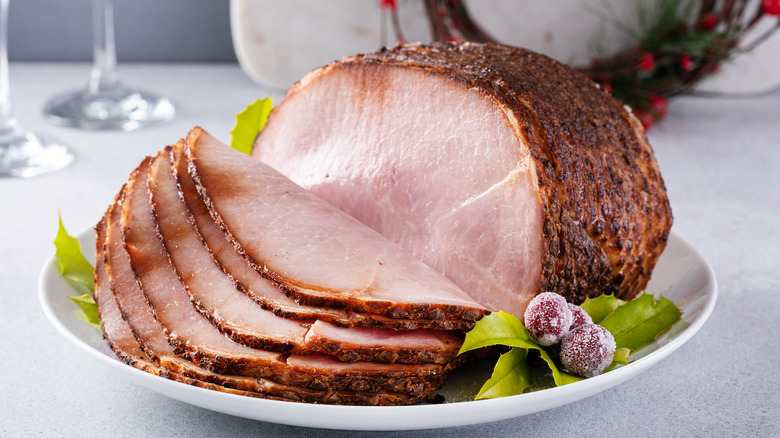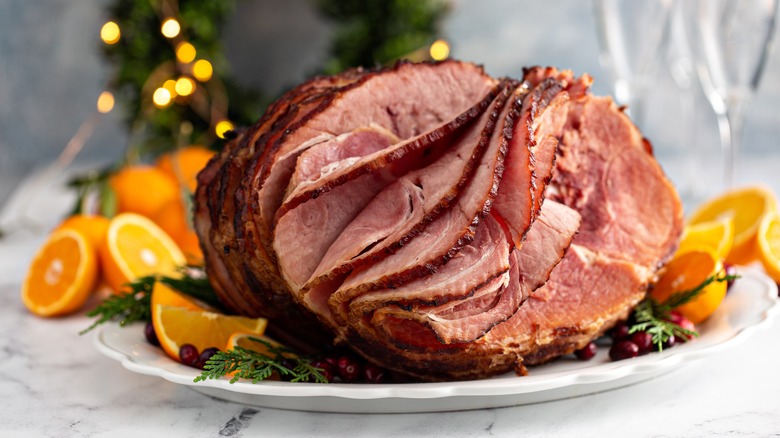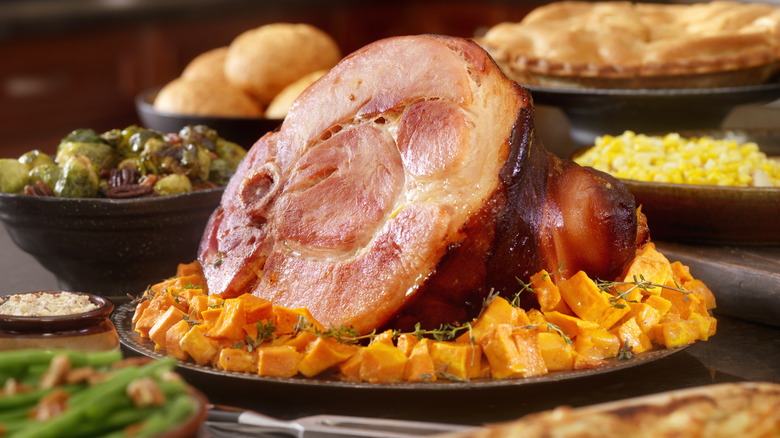The Ham Labels You Need To Avoid At The Grocery Store
Ham might be one of the best centerpiece dishes for any special occasion. Its large size and juicy flesh make it perfect for big holiday parties, and no one will ever get bored with the dish — there are dozens of excellent ham variants such as the Spanish jamón ibérico. With so many types available, home cooks might find it difficult to discern which hams they should gravitate towards or steer away from. If you're choosing a ham at the grocery store, watch out for cuts that have additional water. You could not only be ruining the taste of your final product but also losing money down the line.
During processing, hams are often infused with a salty brine that not only keeps them juicy but aids the curing process. This liquid, especially when used in excess, makes the flesh mushy over time, creating an unappealing texture for what should otherwise be a sturdy, meaty meal. Be particularly wary of "ham and water" products, as brine makes up over 15% of their weight. Hams labeled with "water added" are a little better since they have less added liquid, but generally, you'll want to keep an eye out for products that have no brine added. If you can't find pure cuts of ham at your local grocery store, you can opt for hams "with juices," as these contain small amounts of brine.
Dunk your ham in water to remove water -- you read that right
If you've already bought a ham and find that you bought one with extra brine, don't worry. You can easily get rid of that excess curing liquid by submerging your ham inside a container full of water. Yes, it sounds counter-intuitive, but it's true. This happens through osmosis, the freshwater drawing out the excess salt. It takes a few hours, so you'll want to refrigerate your ham so that it won't be exposed to room temperature for an extended period of time. Room temperature is known as the danger zone (40 to 140 degrees Fahrenheit), which is when bacteria grow exponentially. There is some debate about how long to soak your ham — some think four to six hours is enough, and others say that really salty meat should be soaked for a full 48, with the water changed every eight hours. Once your soaking is done, take out your cut of meat and dry it as best as you can before starting the cooking process. You'll want your spices to have a dry surface to stick on.
Not sure if your brined ham needs the water treatment? Remove a sliver from the main body of the ham and cook it. If this little bite tastes too briny, you should opt for soaking.
Look for bone-in hams to get the tastiest results in the kitchen
Added liquids should not be the only thing you look out for when it comes to selecting the best hams available for sale. Generally, you'll want to select varieties that will maximize their porky flavor without sacrificing their texture, such as bone-in ham. While bones tend to make carving a little more bothersome, they also add delicious flavor to your ham meat. Plus, the leftover bone can also be used to create a stock or further flavor broths, giving you more bang for your buck in the long run.
If you're not looking forward to carving ham, bone-in spiral-cut varieties are also available for sale. However, pre-sliced ham tends to lose moisture more rapidly in the oven, which makes it more finicky to cook in the long run. Also, remember that hams are considered red meats, so you'll want to pair them with the appropriate accompaniments and drinks to make them truly shine.



